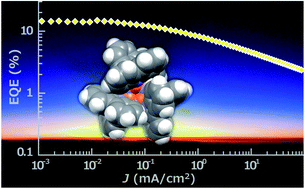A six-carbazole-decorated cyclophosphazene as a host with high triplet energy to realize efficient delayed-fluorescence OLEDs†
Abstract
A high triplet energy (ET) host material, hexakis(9H-carbazol-9-yl)cyclotriphosphazene (PzCz), is used in high-efficiency organic light-emitting diodes (OLEDs). PzCz (ET = 3.00 eV) functions as an effective host for thermally activated delayed fluorescence (TADF) molecules. Highest external electroluminescence quantum efficiencies over 15% and 18% are achieved for blue-green and green TADF-OLEDs, respectively.

- This article is part of the themed collection: Materials Horizons 10th anniversary regional spotlight collection: Asia-Pacific

 Please wait while we load your content...
Please wait while we load your content...